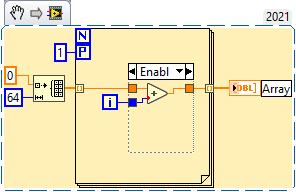Search the Community
Showing results for tags 'x_trick'.
-
I am not sure whether this has been discussed before, but I stumbled upon a simple (alternative) trick to debug parallelized loops that may be of interests to others. Of course there is always the option to edit the parallelism settings and check the "Allow Debugging" box. The "P" terminal is slightly grayed out and parallelism is turned off until the user changes the settings back to not "Allow Debugging". I find it easy to forget or even fail to notice that a parallelized loop is in "Debug" mode due to the very subtle cue that parallelism is turned off. Generally, it is the degraded performance of the code that will trigger a question and then once is off to a rabbit chase for the culprit... A potentially useful trick is to do what is illustrated below: The code inside the loop is encompassed by a disabled structure (set to "Enabled") and the degree of parallelism set to 1. Note that it is not necessary to edit the Loop Parallelism settings! I find the visual cues much easier to notice (and the code easy to revert to full parallelism). Note that it is possible to use a different P value, but in that case you will miss the majority of loops and the actual loop that will be debugged appears to be somewhat random (I have some idea about which ones are, but this is pure guess). This might fit your needs. Once debugged, it is pretty obvious that the parallel loop is not truly "parallel" anymore, and therefore it is hard to forget to revert to a fully parallelized state. HTH.



